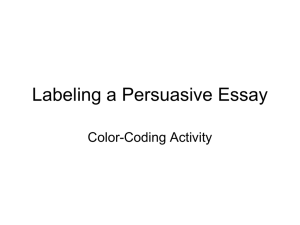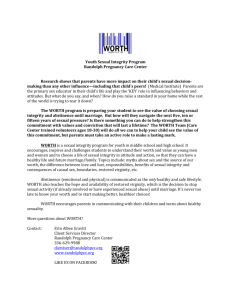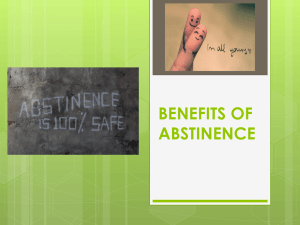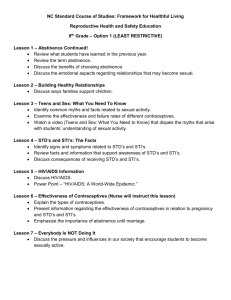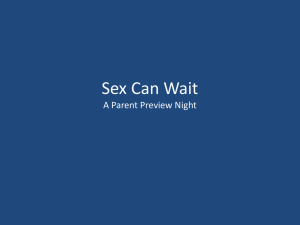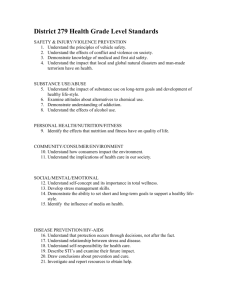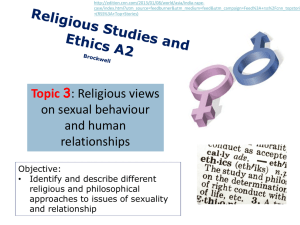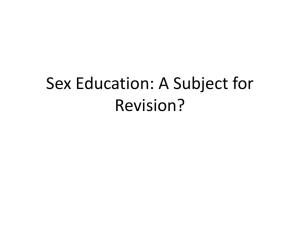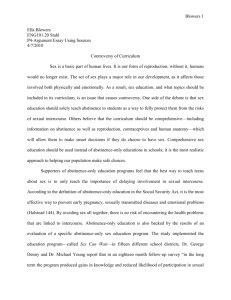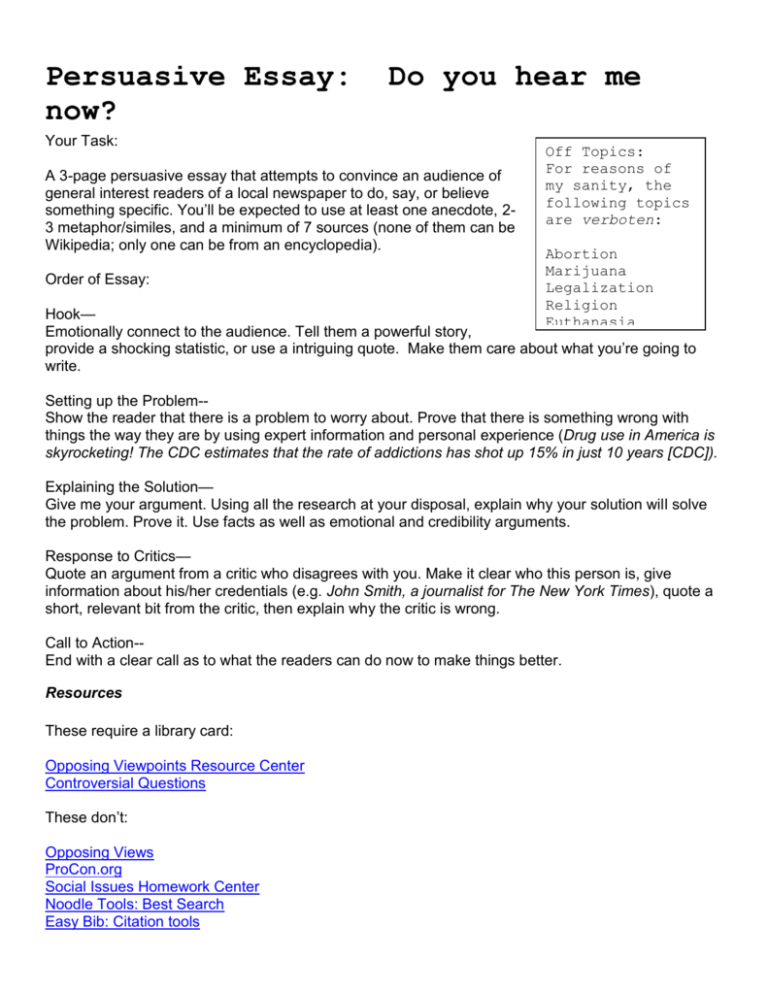
Persuasive Essay:
now?
Do you hear me
Your Task:
A 3-page persuasive essay that attempts to convince an audience of
general interest readers of a local newspaper to do, say, or believe
something specific. You’ll be expected to use at least one anecdote, 23 metaphor/similes, and a minimum of 7 sources (none of them can be
Wikipedia; only one can be from an encyclopedia).
Order of Essay:
Off Topics:
For reasons of
my sanity, the
following topics
are verboten:
Abortion
Marijuana
Legalization
Religion
Euthanasia
Hook—
Emotionally connect to the audience. Tell them a powerful story,
provide a shocking statistic, or use a intriguing quote. Make them care about what you’re going to
write.
Setting up the Problem-Show the reader that there is a problem to worry about. Prove that there is something wrong with
things the way they are by using expert information and personal experience (Drug use in America is
skyrocketing! The CDC estimates that the rate of addictions has shot up 15% in just 10 years [CDC]).
Explaining the Solution—
Give me your argument. Using all the research at your disposal, explain why your solution will solve
the problem. Prove it. Use facts as well as emotional and credibility arguments.
Response to Critics—
Quote an argument from a critic who disagrees with you. Make it clear who this person is, give
information about his/her credentials (e.g. John Smith, a journalist for The New York Times), quote a
short, relevant bit from the critic, then explain why the critic is wrong.
Call to Action-End with a clear call as to what the readers can do now to make things better.
Resources
These require a library card:
Opposing Viewpoints Resource Center
Controversial Questions
These don’t:
Opposing Views
ProCon.org
Social Issues Homework Center
Noodle Tools: Best Search
Easy Bib: Citation tools
What questions do I have about my topic? What do I need to know more about?
What information can help my argument?
Reason #1
Reason #2
Reason #3
Reason #4
What do I already know
about this?
What do I already know
about this?
What do I already know
about this?
What do I already
know about this?
Where can I
learn more?
Where can I
learn more?
Where can I
learn more?
Where can I
learn more?
Research Log:
Reason #1: ____________________________________________________________
Source: ________________________________________
How much do I trust it and why?: ________________________________________
What does it say: _________________________________________________________
________________________________________________________________________
________________________________________________________________________
________________________________________________________________________
Source: ________________________________________
What does it say: _________________________________________________________
________________________________________________________________________
________________________________________________________________________
________________________________________________________________________
Reason #2: ____________________________________________________________
Source: ________________________________________
How much do I trust it and why?: ________________________________________
What does it say: _________________________________________________________
________________________________________________________________________
________________________________________________________________________
________________________________________________________________________
Source: ________________________________________
What does it say: _________________________________________________________
________________________________________________________________________
________________________________________________________________________
________________________________________________________________________
Reason #3: ____________________________________________________________
Source: ________________________________________
How much do I trust it and why?: ________________________________________
What does it say: _________________________________________________________
________________________________________________________________________
________________________________________________________________________
________________________________________________________________________
Source: ________________________________________
How much do I trust it and why?: ________________________________________
What does it say: _________________________________________________________
________________________________________________________________________
________________________________________________________________________
________________________________________________________________________
Reason #4: ____________________________________________________________
Source: ________________________________________
How much do I trust it and why?: ________________________________________
What does it say: _________________________________________________________
________________________________________________________________________
________________________________________________________________________
________________________________________________________________________
Source: ________________________________________
What does it say: _________________________________________________________
________________________________________________________________________
________________________________________________________________________
________________________________________________________________________
Remember the Order:
1.
2.
3.
4.
5.
Hook the reader
Set-up the problem
Explain your solution
Defend it against critics
End with a call to action
Student
Abstinence Miseducation
Most teenagers want to have sex. Certainly not all of them, and certainly not all of them will have sex
while in their teen years, but many will—up to half of all adolescents are in some way sexually active (Satcher).
Abstinence-only sex education, however, doesn’t address this at all. Focused only on why people should wait
until marriage or at least a committed relationship, these programs often do not address contraceptives and
STDs; when they do, they often contain glaring inaccuracies and omissions that ultimately could mislead youth
and cause them to make hazardous decisions about their health.
Sex education in America is controlled mainly at the state and district level, but in order for programs to
get federal funding, they have to follow the government’s standards. There are very specific requirements
written into the 1996 Welfare Reform Act that a program seeking a grant must meet in order to be considered to
receive funding. Grants will be given to programs that, along with other strict guidelines, teach “abstinence
from sexual activity outside marriage as the expected standard for all school age children…that sexual activity
outside of the context of marriage is likely to have harmful psychological and physical effects…that a mutually
faithful monogamous relationship in context of marriage is the expected standard of human sexual activity”
(Shadegg). If programs meet these requirements, the content is not reviewed for accuracy. The language of the
law also totally eliminates any addressing of homosexual teen issues, as programs must stress marriage as the
only appropriate venue for sexual activity (Schleifer).
Thirty-eight of the fifty states require additional HIV/AIDS information to be presented by health
classes in schools, but it is not federally mandated (Schleifer). Information about contraceptive or condom use
is also not required (or, it seems, desired) for a program to receive a federal grant, so many programs do not
include these at all (Shadegg). Abstinence programs are legally unable to address the concerns of gay and
lesbian teens, and homosexuality is often only addressed as a risk factor for STDs (Schleifer). The Waxman
Report also found the programs to be riddled with false statements about the consequences of abortion; it was
claimed in multiple programs that the risks of birth defects, sterility, tubal pregnancies, and premature birth is
increased following an abortion, which goes against accepted obstetric information. (Waxman)
For the 2006 fiscal year, $113,000,000 was appropriated solely for giving grants to abstinence-based sex
education programs through the White House’s Faith-Based and Community Initiatives grant program (Bush).
Despite a detailed investigation of 13 of the United States’ most-commonly used abstinence programs (ordered
and completed for Rep. Henry Waxman in 2004), federal funding for these programs has remained high—even
though the study found that 11 of those 13 programs contained factual errors and often misinterpreted and
twisted study results to make contraceptives look more risky than it has been proven medically that they are.
One program claimed that HIV can be transmitted through sweat and tears; others imply that condoms have not
been statistically shown to reduce the spread of STDs (Waxman). The students of United States health classes
should not be presented with false information about contraceptive measures and sexually transmitted diseases.
Abstinence is a completely valid option and should still be presented to students, but it should not be their only
option, and it should not be surrounded by misconstrued statistics and moral opinions. The conditions for
federal funding should be changed so that fact-checking is required, other contraceptive options are presented
neutrally, and abstinence is promoted sans its current moral and religious overtones.
Government officials often believe that it has a role in influencing the decisions that children make about
their own sexual behavior. President Bush said in a speech in 2007, “When our children face a choice between
self-restraint and self-destruction, government should not be neutral. Government should not sell children short
by assuming they are incapable of acting responsibly. We must promote the good choices.” (Bush) President
George Bush is in favor of implementing abstinence education, and under his presidency its funding has
increased significantly, from about $80 million for the 2001 fiscal year to $175 million for 2006 (Shadegg). His
promotion of ‘choices,’ however, seems specious—how are students supposed to have choice when they are
only presented with the one option? The presentation of contraceptives and information about abortions should
be possible without saying that their use is good or bad—this would even be in sync with the requirements for
programs to receive funding. President Bush should be true to his word, and present more options to teens that
may be or may want to be sexually active. If you only give them the option of staying abstinent until marriage,
what responsibility are they really being given? The government should be addressing the informational needs
of teens, not trying to impose morality upon them by preaching that “a mutually faithful monogamous
relationship in context of marriage is the expected standard of human sexual activity.”
Abstinence-only sex education is the worst kind of censorship—its omissions may very well endanger
the health of students who are not taught about safe sexual behavior, and what it does tell is often exaggerated,
misleading, or just plain incorrect.
Comprehensive sex education shouldn’t be graphic (or in any way
pornographic) in its portrayal or explanations of safe sexual behavior, but it should provide students with
accurate information on contraceptives, STDs, and HIV/AIDS. Students have the right to be taught and learn
facts, not opinions. The federal government should be open to a comprehensive view of sex education, and
funding should be granted accordingly.
Works Cited
Satcher, David. United States. Surgeon General. Department of Health & Human Services. The
Surgeon General's Call to Action to Promote Sexual Health and Responsible Sexual Behavior. 9 July
2001. 24 Jan. 2008 <http://www.surgeongeneral.gov/library/sexualhealth/call.htm>.
Schleifer, Rebecca. Ingorance Only: HIV/AIDS, Human Rights and Federally
Funded AbstinenceOnly Progras in the United States. Ed. Joanne Csete, Jamie Fellner, Dinah Pokempner, James Ross,
and Ian Gorvin. New York:
Human Rights Watch, 2002. 24 Jan. 2008
<http://hrw.org/reports/2002/usa0902/USA0902.pdf>.
"Sex Education." National Coalition Against Censorship. 8 Feb. 2007. 24 Jan.
<http://www.ncac.org/action_issues/Sex_Education.cfm>.
2008
Shadegg, John. United States. Cong. House. Policy Brief - Abstinence Education. Sept. 2003. 28 Jan.
2008 <http://johnshadegg.house.gov/RSC/Abstinence1.PDF>.
Bush, George. The White House. Federal Funds for Organizations That
Help Those in Need. May
2006. 28 Jan. 2008 <http://www.whitehouse.gov/government/fbci/grants-catalog-052006.pdf>.
Waxman, Henry A. United States. Cong. House. The Content of Federally Funded
Only Education Programs. Dec. 2004. 26 Jan. 2008
<http://oversight.house.gov/documents/20041201102153-50247.pdf>.
Abstinence-

